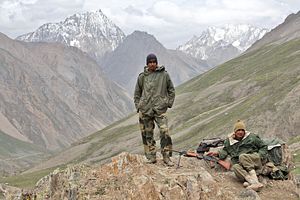In his book, The Future of Land Warfare, Brookings’ expert, Michael O’Hanlon uses an illustrative scenario to argue for maintaining a U.S. land warfare capability. To O’Hanlon, one utility of land forces would be in “handling the aftermath of a major and complex humanitarian disaster superimposed on a security crisis – perhaps in South Asia.”
In O’Hanlon’s scenario, India and Pakistan come to the threshold of all-out nuclear war. He considers this scenario “all too plausible” and a “real possibility today.” O’Hanlon is right that a nuclear confrontation would be devastating to South Asia, for the global economy and environment, and for “loose nukes.” While its probability is an open question, O’Hanlon presents the threat for his own purposes: to get the U.S. to maintain a large standing army.
Of consequence for South Asia is O’Hanlon’s belief that a nuclear exchange would result in a changed political scenario in which international intervention, with U.S. participation, will be eminently justifiable and therefore is well nigh plausible. A nuclear conflict could trigger external intervention in the form of a UN mandated international force to help stabilize the situation, being deployed in Kashmir. To him, India may be amenable to this if it “seemed the only way to reverse the momentum toward all-out nuclear war in South Asia.”
What this suggests is that a war would bring Kashmir center stage as nothing else would. This brings into question why India is leveraging hard power – intelligence and military – in its Pakistan strategy.
India is widely taken as the status quo power since it has the prize, Kashmir. Pakistan is considered revisionist, since it wishes to overturn the status quo on Kashmir. As the status quo power, keeping Kashmir off the radar screen is in India’s interest. For Pakistan, keeping Kashmir in the news for the wrong reasons is enough. A war would concentrate international attention like nothing else.
There is convincing evidence to suggest that even a regional nuclear conflict with just a few weapons opens up the possibility of environmental catastrophe, potentially causing more than a billion casualties worldwide. Therefore, if Kashmir is at the root of a conflict that threatens such a prohibitive cost, calls for forceful international intervention would be justifiable.
It can be argued that a war such as Kargil did not catalyze the international attention Pakistan expected. Instead it redounded on Pakistan, enabling India to over time dehyphenate from Pakistan.
However, the two countries’ nuclear arsenals were then in their infancy. Today the numbers are not only in the triple digits for both sides, but there are elaborate doctrines and structures in place. Nuclear weapons have to be usable to deter. The readiness to use nuclear weapons is useful in so far as deterrence goes, but it is also the Achilles heel of the whole deterrence enterprise.
Pakistan for its part has proclaimed that it would be quick on the draw. India’s response promises to be fast and overwhelming. The two doctrines are like the interactions of two unstable substances.
India has lately shortened its fuse. By calling off the National Security Adviser talks last month, India has chosen remove negotiations as a buffer. It can no longer call off talks to show it is “doing something.” Instead, it will have to actually “do something,” using its hard power, in the face of any Pakistani provocation.
This can serve to deter the rational element in the Pakistani establishment. However, it is well known that there are contending power centers in Pakistan. There is the “deep state,” the “rogue elements” and “good terrorists.” These stand to expand their power base under the shadow of crisis and chaos of war.
That India does not rule out future provocation is evident from the extraordinary lengths it has been going to deter such provocations over the past year. At a joint services seminar commemorating the Indo-Pakistani War of 1965, India’s Army chief said that the Army is prepared for a short, sharp war to be launched in quick time. As O’Hanlon reckons, this will drag Kashmir center stage.
There is another “pull factor” in play.
In case of war, India can at best get back at Pakistan. It cannot get Pakistan to roll back elements that, in striking India, have endangered Pakistan. Such a roll back cannot be in the face of visible Indian military coercion and would not be achieved without something on offer.
In effect, Kashmir stands to figure twice over in the denouement. India will have to throw in a “solution” to Kashmir as an incentive for Pakistani action against terrorists who have gone over the top. And, second, India may be forced to use Kashmir as a de-escalatory chip. This is the price for having gone nuclear.
Kashmir would be back on the agenda, something Pakistan could not manage after either the war fifty years ago or the more recent Kargil War.
Pakistan’s ruling out talks without Kashmir figuring in them leaves India with only one choice: hard power. Whereas India justifies this as essential for deterrence, it bears reminding that if deterrence fails, Kashmir will be back on the agenda and with a bang. If this is not to be a nuclear one, India had better get those “first ever” NSA level talks back on track sooner rather than later.
Ali Ahmed is author of India’s Doctrine Puzzle: Limiting War in South Asia, On War in South Asia and On Peace in South Asia. He blogs at www.ali-writings.blogspot.in. There views here are his own.

































